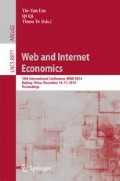Abstract
A durable good is a long-lasting good that can be consumed repeatedly over time, and a duropolist is a monopolist in the market of a durable good. Theoretically, less is known about durable goods than their more well-studied counterparts, consumable and perishable goods. It was quite startling, therefore, when Ronald Coase (1972) conjectured that a duropolist has no monopoly power at all! Specifically, a duropolist who lacks commitment power cannot sell the good above the competitive price if the time between periods approaches zero. The Coase conjecture was first proved by Gul et al. (1986) under an infinite time horizon model with non-atomic consumers. Remarkably, the situation changes dramatically for atomic consumers and an infinite time horizon. Bagnoli et al. (1989) showed the existence of a subgame perfect Nash equilibrium where the duropolist extracts all the consumer surplus, provided the discount factor is large enough. Thus, for atomic consumers, the duropolist may have perfect price discriminatory power! Observe that, in these cases, duropoly profits are either arbitrarily smaller or arbitrarily larger than the corresponding static monopoly profits - the profit a monopolist for an equivalent consumable good could generate. Neither situation accords in practice with the profitability of durable good producers. Indeed we show that the results of Gul et al. (1986) and Bagnoli et al. (1989) are driven by the infinite time horizons. For finite time horizons, duropoly profits for any equilibrium satisfying the standard skimming property closely relate to static monopoly profits. In particular, for atomic agents, we prove that duropoly profits are always at least as large as static monopoly profits, but never exceed double the static monopoly profits.
Access this chapter
Tax calculation will be finalised at checkout
Purchases are for personal use only
References
Bagnoli, M., Salant, S.W., Swierzbinski, J.E.: Durable-goods monopoly with discrete demand. The Journal of Political Economy 97, 1459–1478 (1989)
Coase, R.H.: Durability and monopoly. Journal of Law and Economics 15, 143–149 (1972)
Gul, F., Sonnenschein, H., Wilson, R.: Foundations of dynamic monopoly and the coase conjecture. Journal of Economic Theory 39, 155–190 (1986)
Author information
Authors and Affiliations
Editor information
Editors and Affiliations
Rights and permissions
Copyright information
© 2014 Springer International Publishing Switzerland
About this paper
Cite this paper
Berbeglia, G., Sloan, P., Vetta, A. (2014). Bounds on the Profitability of a Durable Good Monopolist. In: Liu, TY., Qi, Q., Ye, Y. (eds) Web and Internet Economics. WINE 2014. Lecture Notes in Computer Science, vol 8877. Springer, Cham. https://doi.org/10.1007/978-3-319-13129-0_23
Download citation
DOI: https://doi.org/10.1007/978-3-319-13129-0_23
Publisher Name: Springer, Cham
Print ISBN: 978-3-319-13128-3
Online ISBN: 978-3-319-13129-0
eBook Packages: Computer ScienceComputer Science (R0)

